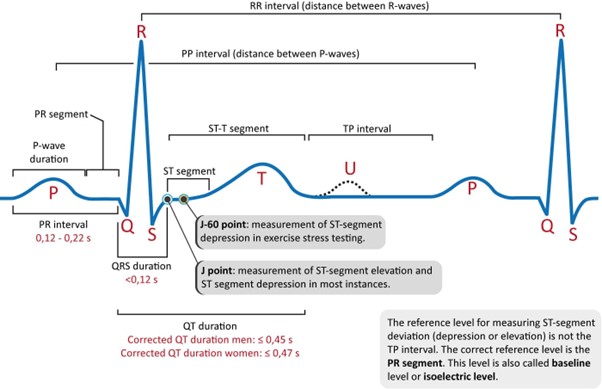A patient is admitted to the emergency department (ED) for shock of unknown etiology. The first action by the nurse should be to
obtain the blood pressure.
Check the level of consciousness.
administer oxygen.
obtain a 12-lead electrocardiogram (ECG).
The Correct Answer is B
Assessing the patient's level of consciousness is a critical initial step in evaluating a patient with shock. Altered mental status or decreased level of consciousness can be indicative of inadequate cerebral perfusion and may require immediate interventions to address compromised brain function and ensure patient safety.
While all the options mentioned are important in the assessment and management of a patient in shock, checking the level of consciousness takes priority as it provides essential information about the patient's neurological status and helps guide further interventions.
A. Obtaining the blood pressure in (option A) is incorrect because Assessing blood pressure is crucial in evaluating a patient in shock, but it can be done in conjunction with checking the level of consciousness and other vital signs.
C. Administering oxygen in (option C) is incorrect because: Administering oxygen is important in managing shock, as tissue hypoxia is a key concern. However, it can be done simultaneously with assessing the level of consciousness and initiating other interventions.
D. Obtaining a 12-lead electrocardiogram (ECG) in (option D) is incorrect because While an ECG may provide valuable information about the patient's cardiac function, it is not the first priority in a patient with shock of unknown etiology. Assessing the level of consciousness and vital signs takes precedence.
Nursing Test Bank
Naxlex Comprehensive Predictor Exams
Related Questions
Correct Answer is A
Explanation
The QTc (corrected QT) interval is a measure of the time it takes for the ventricles to depolarize and repolarize during a cardiac cycle. It is corrected for heart rate (HR) to account for variations in the cardiac cycle length.
The normal range for the QTc interval varies depending on the calculation method used but generally falls within 0.36 to 0.44 seconds. In the given options, the range of 0.33 to 0.47 seconds for the QTc interval is wider than the normal range, suggesting a prolonged QTc interval, which can be indicative of a potential risk for arrhythmias, including ventricular tachycardia and torsades de pointes.
B. QT interval that varies with HR in (option B) is normal because The QT interval alone can vary with heart rate, and this is considered a normal physiological adaptation.
C. QRS interval <0.12 seconds in (option C) is normal because The QRS interval represents the time it takes for ventricular depolarization and is normally less than 0.12 seconds.
D. PR interval 0.12 to 0.24 seconds in (option D) is normal because The PR interval represents the time it takes for atrial depolarization and conduction through the AV node. The normal range is typically 0.12 to 0.20 seconds.

Correct Answer is B
Explanation
Lactate is a by-product of anaerobic metabolism that accumulates when there is insufficient oxygen supply to meet cellular metabolic demands. In the context of severe tissue hypoxia, such as in septic shock, the body may resort to anaerobic metabolism, leading to increased lactate production and elevated lactate levels in the blood.
Elevated lactate levels, typically above 4.0 mmol/L, are indicative of tissue hypoxia and inadequate oxygenation at the cellular level. Higher lactate levels, such as 9.0 mmol/L, suggest more severe tissue hypoxia and increased anaerobic metabolism.
A. Partial thromboplastin time (PTT) 64 seconds in (option A) is incorrect because: PTT is a laboratory test that evaluates the intrinsic pathway of the coagulation cascade. While coagulation abnormalities may occur in septic shock, PTT alone does not specifically indicate severe tissue hypoxia.
C. Potassium 2.8 mEq/L (2.8 mmol/L) (option C) is incorrect because Low potassium levels (hypokalemia) can be a concern in septic shock, but it does not directly indicate severe tissue hypoxia.
D. PaCO2 58 mm Hg in (option D) is incorrect because: PaCO2 refers to the partial pressure of carbon dioxide in arterial blood and is a measure of the respiratory status. While an elevated PaCO2 can be a sign of respiratory acidosis, it is not specific to severe tissue hypoxia.
Therefore, in a critically ill patient with septic shock, an elevated lactate level, such as 9.0 mmol/L, indicates severe tissue hypoxia and inadequate oxygenation at the cellular level
Whether you are a student looking to ace your exams or a practicing nurse seeking to enhance your expertise , our nursing education contents will empower you with the confidence and competence to make a difference in the lives of patients and become a respected leader in the healthcare field.
Visit Naxlex, invest in your future and unlock endless possibilities with our unparalleled nursing education contents today
Report Wrong Answer on the Current Question
Do you disagree with the answer? If yes, what is your expected answer? Explain.
Kindly be descriptive with the issue you are facing.
